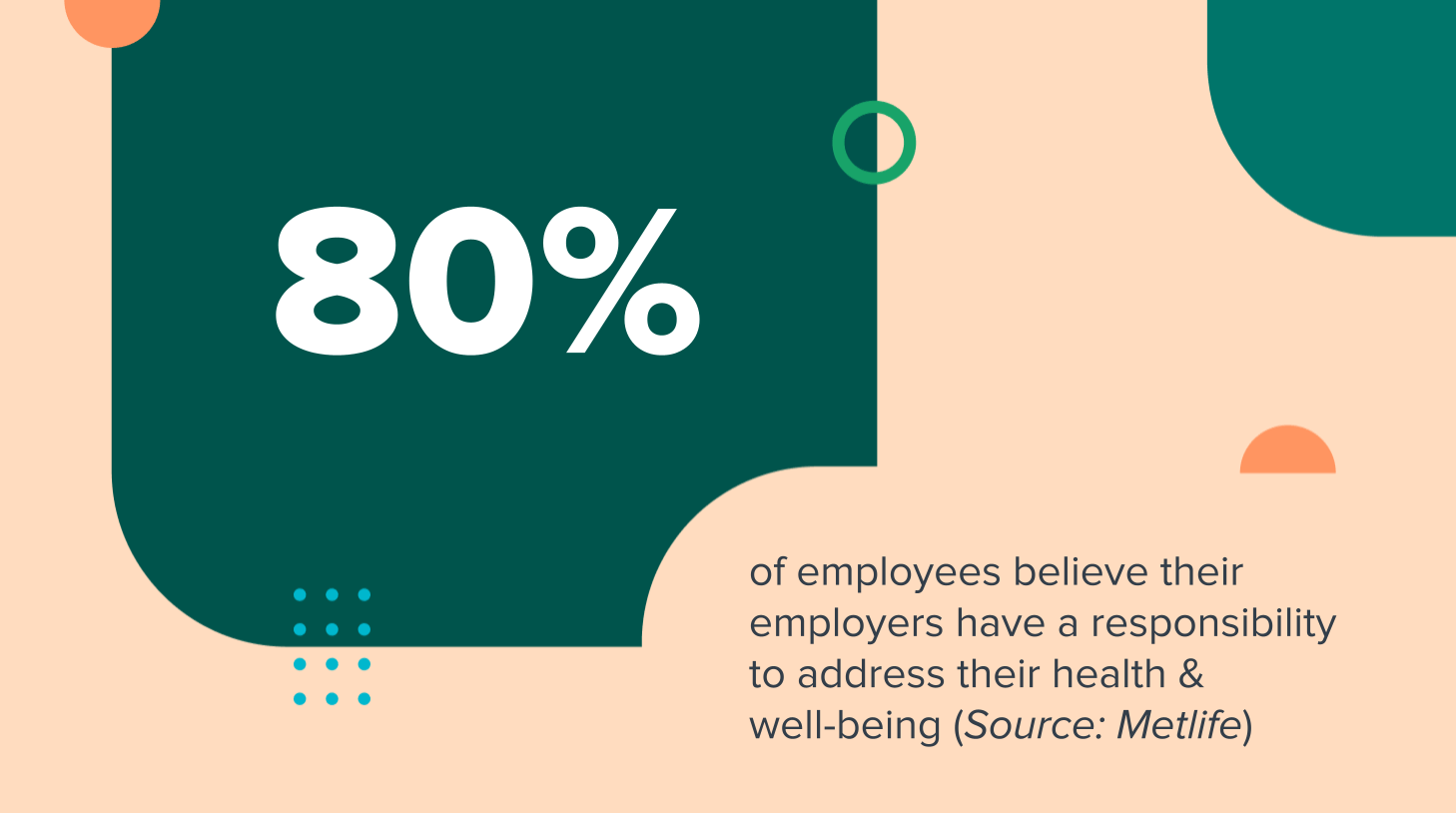How to take care of your remote employees’ mental health
Though the COVID-19 pandemic centers around an infectious disease that impacts the physical human body, its impact has been catastrophic to many other aspects of our collective health – particularly mental health.

A Metlife annual benefits report conducted a few months into the pandemic revealed that:
- 44% of employees now have serious concerns about their physical, mental, and social health
- 80% of employees believe their employers have a responsibility to address their health and wellbeing, especially during COVID-19 – up from 73% pre-pandemic
Another study from the beginning of 2021 charted a 50% rise in depression and a 60% drop in focus among all ages in the workplace.
More recently, a new survey of 2,800 workers from global staffing firm Robert Half showed more than four in 10 employees (44%) say they are more burned out on the job today compared to a year ago. This is up from 34% in a similar 2020 poll.
And overall, nearly half of American workers have been suffering from mental health issues since the COVID-19 pandemic began.
When you don’t support employee mental health
Based on these numbers alone, it’s clear why employee mental health is top of mind for companies as they try to acclimate to a totally new work world that, for most companies, will include some remote work. What happens, then, when companies don’t pay attention to employee mental health? What are the tangible repercussions of employee burnout?
A recent Gallup study on employee burnout shows that employees who say they very often or always experience burnout at work are:
- 63% more likely to take a sick day
- 23% more likely to visit the emergency room
- 2.6x as likely to be actively seeking a different job
- 13% less confident in their performance
Burnout and depression also overlap, which means ignoring employee burnout in your organization can lead to even more complex mental health challenges – not to mention the major impact it can have on overall productivity.
4 tips to support mental health remotely
- Take a collective pause
- Address meeting fatigue
- Let employees self-direct their mental wellness
- The four-day workweek
What can companies do about all of this? First, recognize that being supportive of your employees’ mental health is not just about burnout prevention, but fostering a supportive workplace that addresses your employees’ wellness needs no matter where they are.
To do that, here are four effective approaches companies around the world are taking to care for employees’ mental health:
1. Take a collective pause
Prior to the pandemic, 55% of American workers didn’t use up all of their paid vacation time – and even when they did, they often took their work with them. One of the main reasons employees typically hesitate to take time off is because they struggle to find the “right” time and worry their boss will judge them.
It’s only gotten worse after the pandemic. As a result of long-term remote work, employees are logging in more hours and facing bigger workloads, meanwhile putting off vacation because there’s nowhere to go and they feel like they can’t justify it.
Give them a break
A remedy for that, which more and more companies are starting to turn to after more than a year and a half at home, is company-wide days off for mental health.
LinkedIn made headlines in giving its 15,900 full-time employees a paid week off in April to help them combat burnout and encourage them to unplug and recharge. Hubspot and Hootsuite recently did the same. And if a week feels too long, companies including SAP, Cisco, Google, and Thomson Reuters opted for a company-wide mental health day.
What’s powerful about this tactic is that it shows that your company cares enough about employees’ health to dedicate a period of rest specifically for that purpose, even if that means losing those hours of productivity.
The benefits go beyond those actual days off as well. Because your company is the one proactively initiating the time off, it removes the added stress that individual employees feel when working up the effort and energy to ask for any amount of time off themselves. Also, the fact that everyone is out of office at the same time means employees don’t have to feel like they’re leaving their work to someone else – something that 41% of employees feel guilty about when taking PTO.
2. Address meeting fatigue
The average employee attends 62 meetings per month, which adds up to about a fifth of their work hours in meetings. Not only are they getting less of their work done, but – in an age of Zoom calls and remote work – this amounts to an additional energy drain. This leads to lack of motivation, lack of control, and lack of satisfaction from their work achievements; all signs and symptoms of mental health burnout.
One answer for mitigating this mentally taxing meeting fatigue is to institute no-meeting days. Ideally, offer it on the same day every week so employees can enjoy it regularly.
Banish meetings regularly
While companies who implement no-meeting days most often go for a “No-Meeting Monday”, like Uber implemented twice throughout the summer, it can be done on any day. Asana has “No Meeting Wednesdays” and Wilderness has “Deep Work Wednesdays (DWW).”
This simple shift in meeting expectations for all employees, for just one day per week, allows everyone to maintain their focus, concentration, and productivity, rather than having exhausting video calls constantly interrupting and derailing their workflow.
3. Let employees self-direct their mental wellness
Most companies recognize that offering some vacation days doesn’t, on its own, alleviate burnout and so they look to other ways to offer meaningful mental wellness support to their employees. The most popular programs that have filled this need include virtual wellness classes, subscriptions to mental health apps like Headspace and Calm, and online therapy sessions from select providers.
What’s great about these options, for employers at least, is that it “checks the box” of mental wellness support and employees from anywhere can benefit from them. With remote work potentially lasting for another two years, that’s certainly a huge plus. But what isn’t ideal is that it’s also just a catch-all solution – these don’t cover the wide spectrum of individual mental wellness needs employees have, as everyone’s own mental health journey is personal and unique.
Give your employees the power
That’s where empowering your employees to self-direct their mental wellness might be the perfect answer, which is what many companies make possible by offering a wellness stipend.
With a wellness stipend, employees from any place, background, and mental condition can choose what mental health support personally means to them, and in turn the company covers the expense through reimbursement. As the employer, you decide how much the stipend is, what it covers, and how often to renew the benefit – on a per-employee basis, you’ll often find companies offering anywhere from $25-$100 per month, or $200-$1,000 quarterly or yearly.
A wellness stipend allows your employees to go beyond the mediation app or therapist you selected and instead invest in something that actually suits their own mental health needs. Depending on what your company designates as an eligible expense, this can include:
- Sessions with a therapist or counselor (not restricted to any specific providers)
- Subscription to a fitness app of their choosing
- Weight loss membership plan
- Prescription medication
- Health monitoring devices
- Vacation expenses
- Yoga gear or classes
- Hiking gear
- Meal delivery
- Home cleaning services
- Backup childcare
Letting employees personalize their own mental health support with a stipend also happens to align with creating a better and more inclusive employee experience – something that’s key to surviving the Great Resignation and becoming a company that others admire.
Some of the most successful companies today offer wellness stipends. Both Basecamp and Salesforce offer their employees $100 per month to support their wellness, and companies like Facebook, Zoom and Webflow also offer their own wellness reimbursement programs.
4. The four-day workweek
While doing things like giving employees more time off and reducing their overall meeting load are great practices to support employees’ mental health, those strategies represent a small drop in comparison to the 90,000 hours the average person will spend at work in their lifetimes. They feel even less impactful when the working environment employees return to feels like a never-ending cycle of long hours and too much work.
Related: Learn from a company that implemented an alternating four-day workweek for a three-month trial period – and what the results were.
That’s what the four-day workweek addresses – reducing employee stress and promoting work-life balance by making life less about work. It’s a concept that came about well before the pandemic, with some countries giving it a test run back in 2018. It’s now picking up increased interest as employee mental health concerns continue to grow and remote work encourages us all to rethink old workplace traditions.
Alleviate the pressure
The idea is that with an additional day off every week, employees now get more time to regularly cultivate and care for their home and personal lives, where they previously struggled to squeeze into their daily routines or neglected altogether. When the home front is regularly maintained, employees are less stressed, more focused, and able to accomplish as much work (or more) in four days as they do in five.
Consider Parkinson’s Law, an old adage about personal productivity that “work will expand to fill the time allotted for its completion.” In other words, a quick task will take longer to complete because there’s ‘more time’ to complete it. This means that reducing the workweek to 32 hours wouldn’t actually mean less work output in a week’s time, but rather, employees are given a narrower frame of time within which to organize their work more efficiently.
The four-day workweek today is more than just a test concept and has become a legitimate option for companies, and countries, who want to make a significant improvement in employee mental health. It’s the norm in Iceland, after their experiments throughout 2015-2019 were overwhelmingly successful by improving employee well-being and productivity. In early 2020 Finland contemplated moving to a four-day workweek, and more recently this year, countries like Canada, Spain and Japan have warmed to the idea too. Most recently, Scotland joined the experiment in early September.
Your employees need your support
As the workplace continues to shift in the coming months (and years, even) in the face of remote and hybrid work, your employees will be the ones bearing the brunt of the stress and uncertainty. This will do a number on their mental health no matter how resilient they are.
By actively listening for and alleviating the biggest stressors in your employees’ lives, you can get ahead of the potential problems of burnout and mental health, and distinguish yourself as a supportive, progressive employer that people will want to work for. That will be a powerful attractor in these times when employers are struggling to find ideal candidates.





